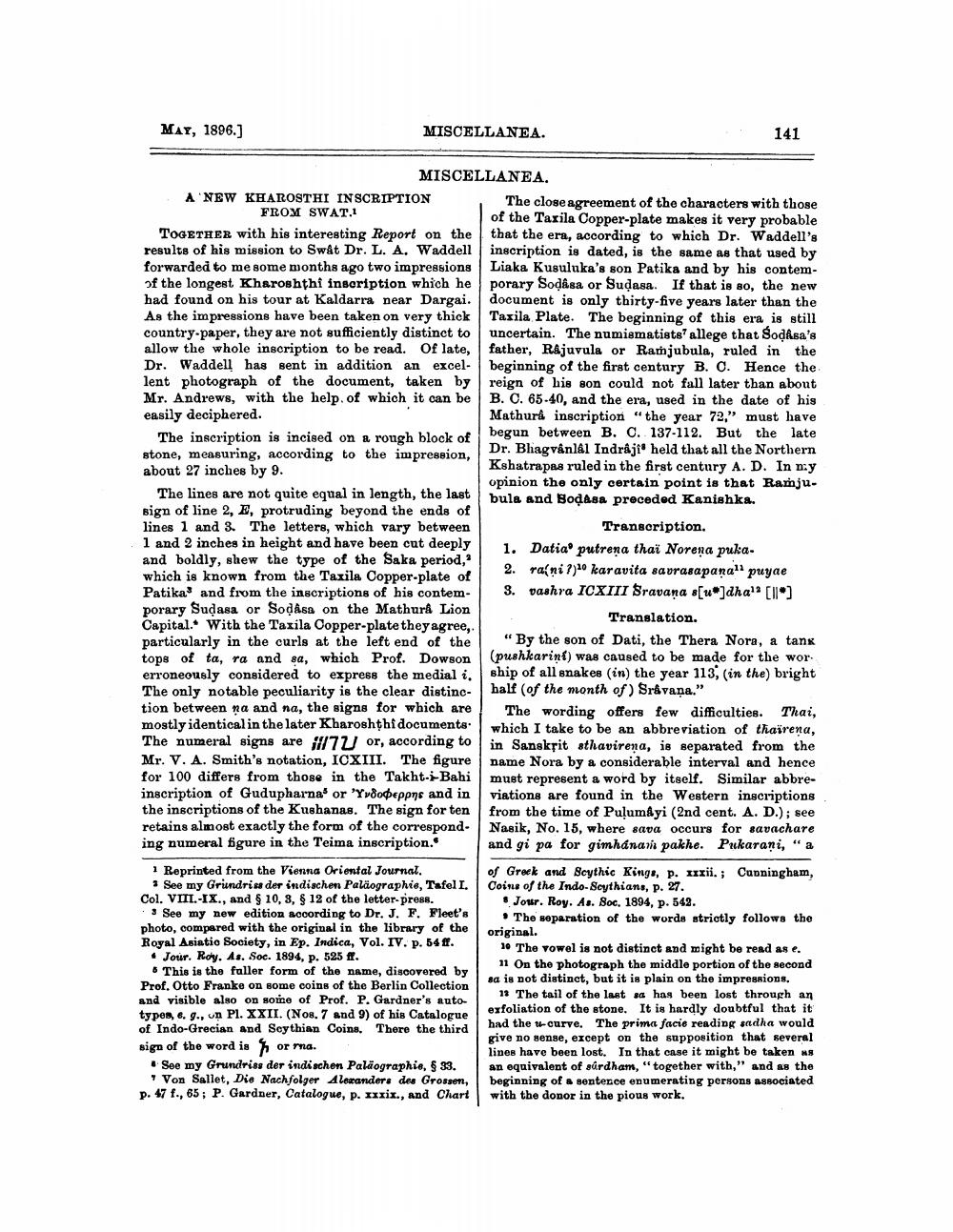________________
MAY, 1896.]
MISCELLANEA.
MISCELLANEA.
A NEW KHAROSTHI INSCRIPTION FROM SWAT.1
TOGETHER with his interesting Report on the results of his mission to Swât Dr. L. A. Waddell forwarded to me some months ago two impressions of the longest Kharoshthi inscription which he had found on his tour at Kaldarra near Dargai. As the impressions have been taken on very thick country-paper, they are not sufficiently distinct to allow the whole inscription to be read. Of late, Dr. Waddell has sent in addition an excellent photograph of the document, taken by Mr. Andrews, with the help. of which it can be easily deciphered.
The inscription is incised on a rough block of stone, measuring, according to the impression,
about 27 inches by 9.
The lines are not quite equal in length, the last sign of line 2, E, protruding beyond the ends of lines 1 and 3. The letters, which vary between 1 and 2 inches in height and have been cut deeply and boldly, shew the type of the Saka period,' which is known from the Taxila Copper-plate of Patika and from the inscriptions of his contemporary Suḍasa or Sodasa on the Mathur Lion Capital. With the Taxila Copper-plate they agree,. particularly in the curls at the left end of the tops of ta, ra and sa, which Prof. Dowson erroneously considered to express the medial i. The only notable peculiarity is the clear distinction between na and na, the signs for which are mostly identical in the later Kharoshṭhi documents The numeral signs are 7 or, according to Mr. V. A. Smith's notation, ICXIII. The figure for 100 differs from those in the Takht-i-Bahi inscription of Gudupharna' or 'Yvôo peppns and in the inscriptions of the Kushanas. The sign for ten retains almost exactly the form of the corresponding numeral figure in the Teima inscription.
1 Reprinted from the Vienna Oriental Journal.
3 See my Grundriss der indischen Paläographie, Tafel I. Col. VIII-IX., and § 10, 3, § 12 of the letter-press.
See my new edition according to Dr. J. F. Fleet's photo, compared with the original in the library of the Royal Asiatic Society, in Ep. Indica, Vol. IV. p. 54 ff. Jour. Roy. As. Soc. 1894, p. 525 ff.
This is the fuller form of the name, discovered by Prof. Otto Franke on some coins of the Berlin Collection and visible also on some of Prof. P. Gardner's autotypes, e. g., un Pl. XXII. (Nos. 7 and 9) of his Catalogue of Indo-Grecian and Scythian Coins. There the third sign of the word is or rna.
See my Grundriss der indischen Paläographie, § 33. Von Sallet, Die Nachfolger Alexanders des Grossen, p. 47 f., 65; P. Gardner, Catalogue, p. xxxix., and Chart
141
The close agreement of the characters with those of the Taxila Copper-plate makes it very probable that the era, according to which Dr. Waddell's inscription is dated, is the same as that used by Liaka Kusuluka's son Patika and by his contemporary Soḍâsa or Suḍasa. If that is so, the new document is only thirty-five years later than the Taxila Plate. The beginning of this era is still uncertain. The numismatists' allege that Sodasa's father, Rajuvula or Ramjubula, ruled in the beginning of the first century B. C. Hence the reign of his son could not fall later than about B. C. 65-40, and the era, used in the date of his Mathura inscription "the year 72," must have begun between B. C. 137-112. But the late Dr. Bhagvânlâl Indrajî held that all the Northern
Kshatrapas ruled in the first century A. D. In my
opinion the only certain point is that Ramjubula and Bodasa preceded Kanishka.
Transcription.
1. Datia putrena thai Norena puka
2.
rani?)10 karavita savrasapana" puyae vashra ICXIII Sravana s[u]dha1 [*]
3.
Translation.
"By the son of Dati, the Thera Nora, a tank (pushkarint) was caused to be made for the wor ship of all snakes (in) the year 113, (in the) bright half (of the month of) Sravana."
The wording offers few difficulties. Thai, which I take to be an abbreviation of thairena, in Sanskrit sthavirena, is separated from the name Nora by a considerable interval and hence must represent a word by itself. Similar abbreviations are found in the Western inscriptions from the time of Pulumâyi (2nd cent. A. D.); see Nasik, No. 15, where sava occurs for savachare and gi pa for gimhánam pakhe. Pukarani, "a
of Greek and Scythic Kings, p. xxxii.; Cunningham, Coins of the Indo-Scythians, p. 27.
Jour. Roy. As. Soc. 1894, p. 542.
The separation of the words strictly follows the original.
10 The vowel is not distinct and might be read as e. 11 On the photograph the middle portion of the second sa is not distinct, but it is plain on the impressions.
12 The tail of the last sa has been lost through an exfoliation of the stone. It is hardly doubtful that it had the u-curve. The prima facie reading sadha would give no sense, except on the supposition that several lines have been lost. In that case it might be taken as an equivalent of sûrdham, "together with," and as the beginning of a sentence enumerating persons associated with the donor in the pious work.




